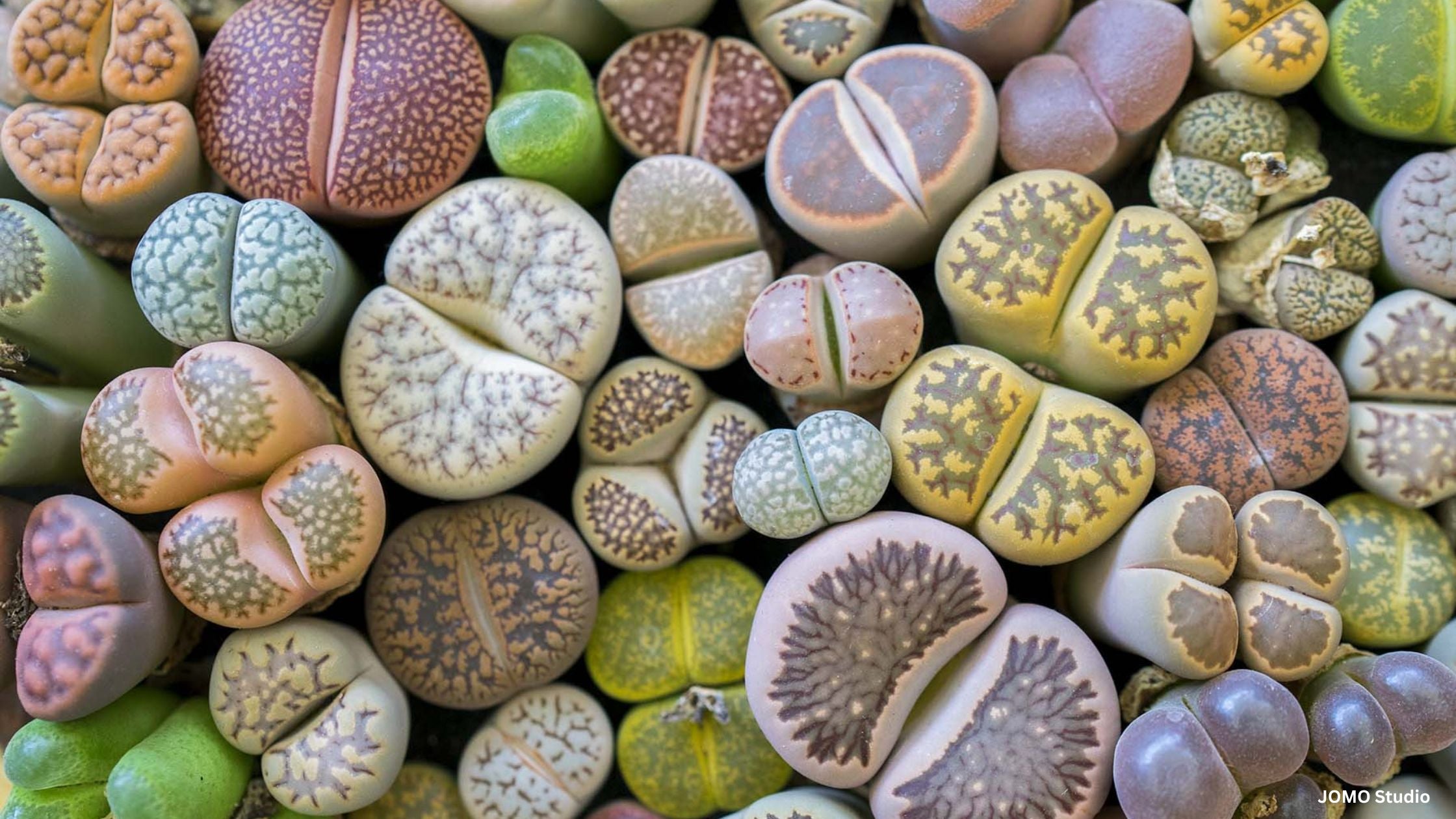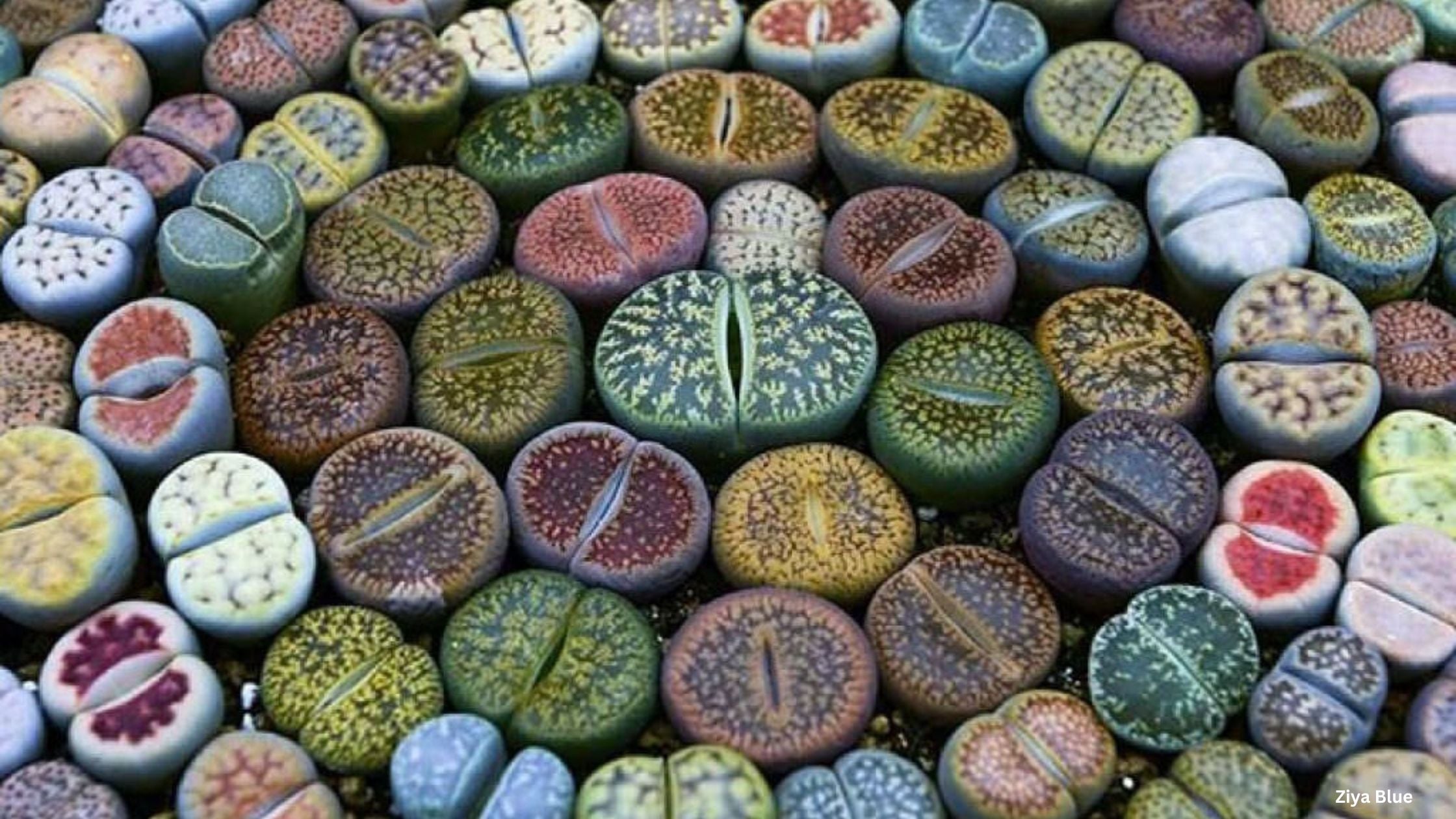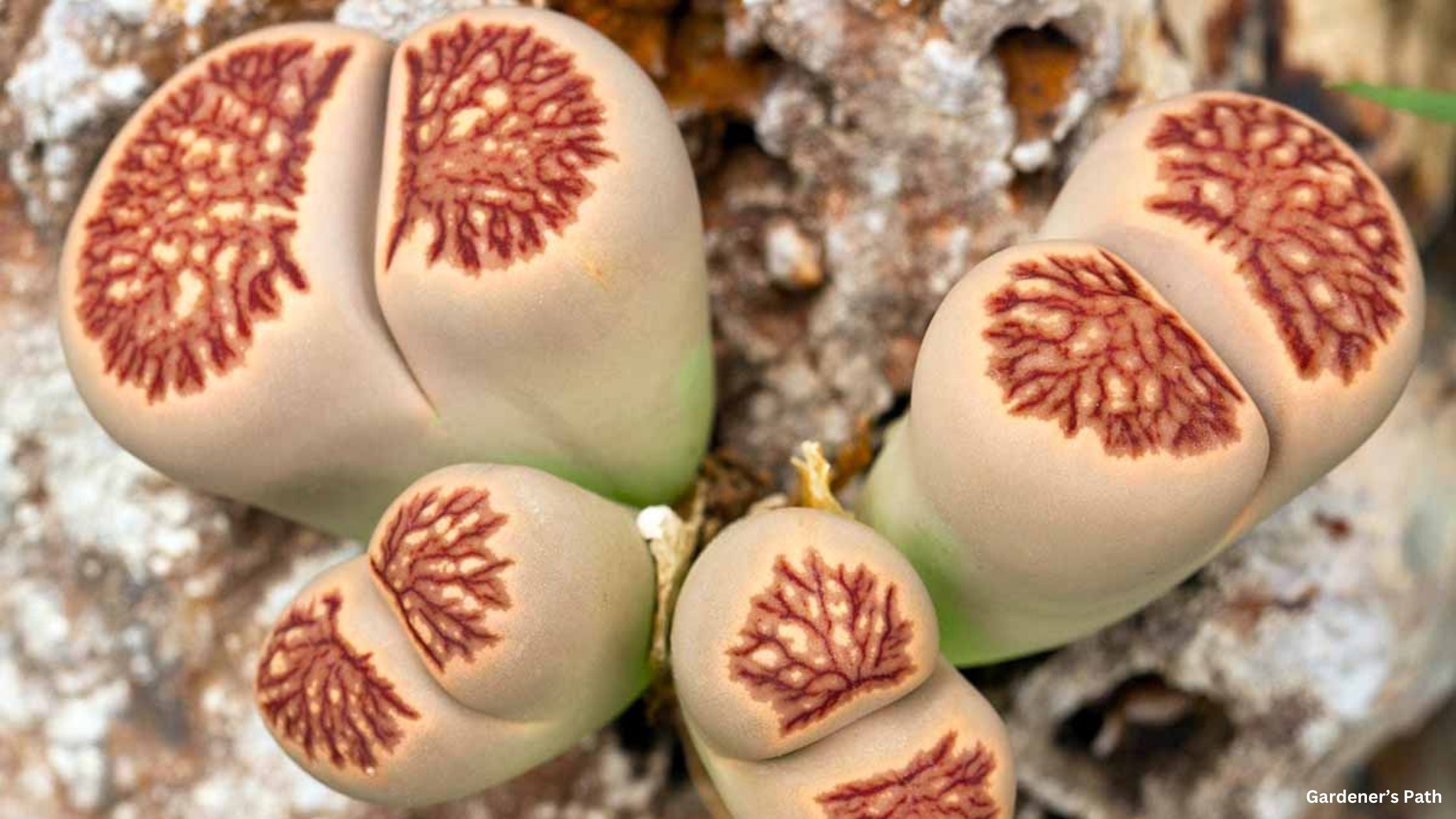Lithops - Living Stones

Lithops spp. or Living Stones are a fascinating group of plants. When you closely look at them, you wonder if these succulents are really plants! The answer of course is yes; they belong to the Ice Plant Family (Aizoaceae). There are 37 species and 145 varieties under the Genus name of Lithops. Litho is the Greek word for Stone and Opsis, the Greek word for face.
Lithops are native to southern Africa. They were discovered in 1811 by botanist William J. Burchell. They naturally grow in stony ground. Their stone-like appearance is a survival adaptation to avoid grazing animals. The plants can be very hard to spot – even for trained botanists! The top epidermal cells of the leaves contain different colors of rusts, brown, green, cream, pink and grey and are patterned to excellently camouflage the plant. Living Stones also come in various shapes and sizes, peeking above the soil 1.5 cm – 2.5 cm at the most and spreading up to 7.5 cm. wide.

The top of a living stone plant is divided into two distinct bulbous leaves that are fused at the bottom where the tap root begins. They do not have a stem. Each leaf stores water and is capable of keeping the plant alive for many months between waterings or when dormant. Some species have multi – headed plants.
Most of the thick leaf of a Lithops is underground. In order to photosynthesize properly, the cells at the top of each leaf let light pass through and enter the underground portions of the plant.
LIthops are happiest when grown at temps of 18-26 C. They can tolerate temps of 32-38 C. Five to six hours of sun at the beginning of the day is recommended. A south or west location provides too much sun causing leaf burn and is best controlled by a sheer curtain.
Living stones are easily started from seed but if you do decide to go the seed route, extreme patience comes into play! The cons are that germination can take months and flowers cannot be expected to appear for 3-4 years. The pros; growing from seed gives you the opportunity to experience more species than what you find in pots at the garden centre.

To start Lithops seed, you will need cactus soil mixed with horticultural grit sand and perlite. Seed starting trays or containers should have excellent drainage to avoid root rot. Start the seeds in late spring to early summer. Follow seed package directions for planting and cover them with a very thin layer of cactus soil. Lithops seeds need light to germinate. Keep the seeded area moist with a gentle spray of tepid water and place in a sunny window until germination occurs. Check daily. The top of the soil should be kept moist but not wet. Germination will take a few weeks with some varieties not germinating for a year! As the seedlings grow, gradually reduce watering frequency. Let the top ¼ inch of top soil dry out before gently watering again. When the seedlings are about three months old, let them dry out completely between waterings. Increase the length of time between waterings so the soil remains totally dry for longer periods of time. You can transplant them into their own pots when they are about a year old. Transplant each seedling carefully as lithops have tap roots which can be broken off easily.
Be aware that Living Stones have an extensive root system and need a deep pot (7.5 -15 cm.) to accommodate the tap and side roots. They will grow happily in a pot for many years. The best pots for living stones are clay pots as air can penetrate the sides to benefit the root system. Prior to planting, cure your clay pots for an hour or so by submerging them in warm water before planting.
A good soil mix for living stones is made up of cacti soil, horticultural grit sand, perlite or any other gritty material that drains extremely well. The number of plants per pot is dependent on the pot diameter. Three plants per six inch (15 cm) pot is lots. After planting, top dress around the living stones with fine or mixed sizes of pebbles and rock.
Propagation can also be accomplished by splitting multi-headed plants. As with transplanting seedlings, take care when splitting the plant roots. Scissors are useful when doing this job. Repot when the growing season starts which is usually during the month of May. Be aware that lithops roots must be at least two years old before you do any repotting. Repotting should be done only if the plant has problems or the plant has outgrown its pot.
To successfully grow Living Stones, it is very important to follow their yearly growth cycle.
From late spring to early summer water the potting medium thoroughly and leave the pot to dry out for two or more weeks. Make sure the plant pot has dried out thoroughly between waterings. If in doubt as to whether your plant needs water or not, err on the side of not watering. You can usually revive a dry plant, but cannot bring one back from excessive root rot.
In mid - summer the Lithops will go dormant. Stop watering. If the plant shrivels up just give it a small amount of water so that the leaves become turgid. Then stop watering again.
Start watering again in late summer and early fall. Fertilize at this time with a very dilute mix of cacti fertilizer or a fertilizer that is low in nitrogen and high in potassium. Do not pour this fertilizer mix over the leaves as it may burn them. The crack between the leaves will begin to open up. This signals that the plant is preparing to flower.

Flowering will not occur until a Living Stone plant is three years old. Their flowers look like a delicate daisy and can be yellow, white, pink or shades of orange. On bright days, they open early in the day and close at night.
Lithops flowers are self-fertile. You can hand pollinate them with a very soft paint brush. If you want to collect seed, let the flower form a seed pod, making sure the flower has totally died back. This will leave just the brown seed pod showing on the top of the plant. In the wild, seed pods are signalled to open by rain falling on the pods. Rain drop splashes disperse the seed; usually close to the mother plant. You can use a water dropper and after a few drops the pod will open. Carefully scrape the seeds out with a toothpick and allow them to air dry. Lithops seeds remain viable for 12 years or more if kept dry, dark and cool. Place in a wax paper envelope or paper envelope and mark as to species and variety. Do not store them in the fridge.
After flowering Lithops go dormant to prepare for new leaf growth. Stop watering.
During winter and early spring allow the soil to dry out completely. By spring the new leaf pair will begin to show. Once the old leaves have thoroughly shrivelled and dried, begin to water again. You must leave the old leaves on the plant as the new leaves use their nutrients to aide in their growth.
The new leaves will form a fissure at right angles to the old leaf fissure.

FYI –
Overwatering is the most common cause of plant death.
Like any tropical plant, Lithops can get mealy, spider mites, scale and aphids. Check your plants weekly. If they do get a pest, refrain from using a chemical spray which will be too harsh for the plant. Isolate the Lithops from your other indoor plants and spray with a mix of 1 tsp of mild dish soap with 1 L of warm water.
Mushy leaves/mushy brown roots; splitting leaves – These problems are caused by overwatering or watering during the dormant period. During their dormant period Living Stones live off the water in their leaves. If you catch root rot early, you can remove the plant from the wet soil, trim off the rotten roots and transplant it into a new dry mix. Sanitize your pruners with rubbing alcohol before, during and after trimming the roots.
Leaves have shrivelled or are wrinkling. – Not enough water during their growing period.
Discolored leaves, leaf stretching or pattern fading – Too little sunlight. A leaf stretching for light is called etiolation. Gradually move the container to a brighter location. Do not put it in full sun right away as this may cause leaf burn and plant death. In one or two years the plant will eventually return to its normal size.
Lithops are non-toxic to humans and pets.
